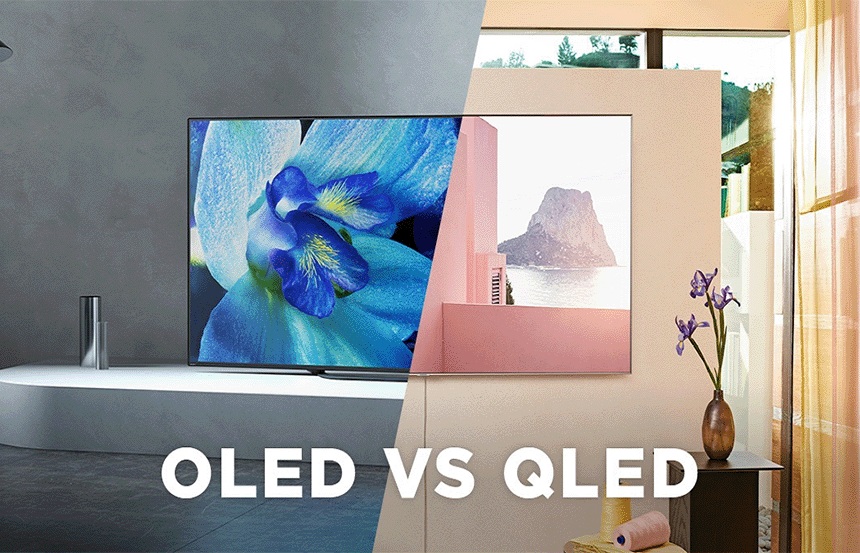In the world of TVs, there's a constant tug-of-war between different technologies, each promising the best viewing experience. Two names that often pop up in this conversation are OLED and QLED. But what exactly sets them apart? Why does it matter? Let's break it down in simple terms.
Understanding The Basics:
Before diving into the specifics, let's understand what OLED and QLED actually mean.
OLED stands for Organic Light Emitting Diode. It's a display technology where each pixel is made of an organic compound that emits light when an electric current passes through it. This means that each pixel can emit its own light and also completely turn off, resulting in deep blacks and vibrant colors.
QLED, on the other hand, stands for Quantum Dot Light Emitting Diode. It's also a type of LED-backlit LCD TV, but with a twist. Quantum dots are tiny semiconductor particles that can emit different colors depending on their size. In QLED TVs, these quantum dots are used to enhance the colors produced by the LED backlighting, resulting in a wider color gamut and improved brightness.
Picture Quality:
When it comes to picture quality, both OLED and QLED have their strengths.
OLED TVs are known for their deep blacks and infinite contrast ratio. Since each pixel can individually turn off, OLED TVs can achieve true blacks, making for stunningly lifelike images with rich colors and detail. This also means that OLED TVs generally have better viewing angles, as the picture remains consistent even when viewed from the side.
On the other hand, QLED TVs excel in brightness. Thanks to the quantum dots, QLED TVs can achieve higher peak brightness levels compared to OLED TVs. This makes them a great choice for rooms with lots of ambient light, as they can maintain a vibrant picture even in well-lit environments. Additionally, QLED TVs often have better HDR (High Dynamic Range) performance, delivering more vivid and lifelike images in HDR content.
Durability And Burn-In:
Durability is another aspect where OLED and QLED differ.
OLED TVs are susceptible to burn-in, a phenomenon where static images displayed for extended periods can leave a permanent ghost image on the screen. This is because organic materials degrade over time, especially when exposed to high levels of brightness. While burn-in is less of an issue with normal usage, it's something to consider if you plan on using your TV for gaming or displaying static elements like news tickers for long periods.
QLED TVs, on the other hand, are not susceptible to burn-in since they use inorganic quantum dots for color production. This makes them a better choice for gaming or use cases where static images are common.
Price And Availability:
Price is often a deciding factor for many consumers, and here's where the difference between OLED and QLED becomes apparent.
OLED TVs tend to be more expensive than their QLED counterparts. This is partly due to the manufacturing process, as producing OLED panels is more complex and yields are lower compared to LCD panels used in QLED TVs. Additionally, OLED TVs are currently produced by a few manufacturers like LG and Sony, which further limits supply and increases prices.
QLED TVs, on the other hand, are more widely available across various brands like Samsung, Sony, and TCL. This increased competition helps drive prices down, making QLED TVs a more budget-friendly option for those looking for premium picture quality without breaking the bank.
Energy Efficiency:
When it comes to energy consumption, OLED and QLED TVs have different characteristics.
OLED TVs are generally more energy-efficient than QLED TVs. This is because OLED panels only consume power for the pixels that are turned on, resulting in lower power consumption, especially when displaying darker scenes. Additionally, OLED TVs do not require a backlight, further reducing energy usage compared to QLED TVs.
QLED TVs, on the other hand, require a backlight to illuminate the quantum dots and produce colors. While newer QLED models have become more energy-efficient over time, they still tend to consume more power than OLED TVs, particularly when displaying brighter scenes.
Response Time And Motion Handling:
For fast-paced content like sports or action movies, response time and motion handling are crucial factors to consider.
OLED TVs generally have faster response times compared to QLED TVs. This means that fast-moving objects appear smoother and clearer on an OLED display, with minimal motion blur. Additionally, OLED panels can switch pixels on and off individually at a much faster rate, further enhancing motion handling.
QLED TVs, while still offering decent motion handling, may exhibit more motion blur due to their slower response times. However, newer QLED models often include features like motion interpolation and black frame insertion to mitigate this issue and provide a smoother viewing experience.
Gaming Features:
For gamers, features like low input lag and variable refresh rate (VRR) support can significantly enhance the gaming experience.
OLED TVs typically have lower input lag compared to QLED TVs, making them more responsive for gaming. This means that actions performed on the controller register faster on the screen, resulting in a more immersive gaming experience with minimal delay.
However, QLED TVs have an edge when it comes to VRR support. Many QLED models support technologies like AMD FreeSync and NVIDIA G-SYNC, which synchronize the TV's refresh rate with the frame rate of compatible gaming consoles or PCs. This helps reduce screen tearing and stuttering, resulting in smoother gameplay.
Size And Design Options:
When it comes to size and design, both OLED and QLED TVs offer a wide range of options to suit different preferences and living spaces.
OLED TVs are available in a variety of sizes, ranging from compact models suitable for smaller rooms to massive screens ideal for home theaters. Additionally, OLED panels are incredibly thin and flexible, allowing for innovative designs like rollable or transparent displays.
QLED TVs also come in various sizes, with options ranging from smaller screens for bedrooms or kitchens to large, immersive displays for dedicated home theaters. While QLED panels may not be as thin as OLED panels, they still offer sleek designs with slim bezels and stylish stands or wall mounts.
Conclusion:
In the end, the choice between OLED and QLED ultimately comes down to your priorities and budget. If you prioritize picture quality above all else and don't mind paying a premium for it, OLED is the way to go. With its deep blacks and stunning contrast, OLED TVs offer an unparalleled viewing experience, especially in dark rooms.
On the other hand, if you're looking for a brighter display with excellent HDR performance and don't want to worry about burn-in, QLED might be the better choice. QLED TVs are more affordable and widely available, making them a great option for those who want premium features without breaking the bank.
In either case, both OLED and QLED offer impressive advancements in TV technology, bringing us closer to the ultimate viewing experience. Whether you're a cinephile, a gamer, or just someone who enjoys binge-watching your favorite shows, there's never been a better time to upgrade your TV and immerse yourself in stunning visuals.










